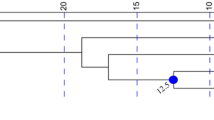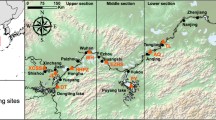Abstract
The Saint Croix ground lizard (Ameiva polops) is a Critically Endangered species endemic to Saint Croix, U.S. Virgin Islands. Although it is completely extirpated from Saint Croix Island (last seen in 1968), two small natural satellite populations survive on two islets off St. Croix: one on Protestant Cay (estimated at ~30 individuals in 2002); and one on Green Cay (estimated at ~180 individuals in 2002). Two additional small populations exist that were founded with individuals translocated from the two surviving natural populations. One is on Ruth Island, a man-made islet off St. Croix, founded in 1990 with 10 individuals from Protestant Cay. The other is on Buck Island, ~2.5 km from Saint Croix, founded in 2008 with 57 individuals from Green Cay. All populations are vulnerable to catastrophic events such as hurricanes, sea level rise, introduction of exotic species, and landscape transformation. Herein, we used mitochondrial and nuclear-microsatellite markers to examine levels of genetic diversity within extant populations of A. polops and the degree of genetic differentiation among them. We also conducted analyses to search for signatures of recent bottlenecks in these populations and to estimate their effective population size (N e ). We found low genetic variability within populations of this lizard, comparable to that observed in other threatened vertebrates. We also found significant genetic differentiation among the three populations examined, as well as signatures of recent bottlenecks and critically low N e values in all populations. Based on our results, we suggest two different conservation units for A. polops: (1) Green Cay and its replicate population at Buck Island; and (2) Protestant Cay and its replicate population at Ruth Island. We discuss the implications of our findings on the conservation and management of A. polops.




Similar content being viewed by others
References
Allendorf FW, Luikart G (2007) Conservation and the genetics of populations. Blackwell, Oxford
Arnold ML (1997) Natural hybridization and evolution. Oxford University Press, Oxford
Barbour T, Noble GK (1915) A revision of the lizards of the genus Ameiva. Bull Mus Comp Zool 59:417–479
Baskin JN, Williams EE (1966) The Lesser Antillean Ameiva (Sauria, Teiidae). Stud Fauna Curacao Caribb Isl 89:144–176
Carlsson J (2008) Effects of microsatellite null alleles on assignment testing. J Hered 99(6):616–623. doi:10.1093/jhered/esn048
Censky EJ (1995) Mating strategy and reproductive success in the Teiid Lizard, Ameiva plei. Behaviour 132(7/8):529–557
Chapuis M-P, Estoup A (2007) Microsatellite null alleles and estimation of population differentiation. Mol Biol Evol 24(3):621–631. doi:10.1093/molbev/msl191
Di Rienzo A, Peterson AC, Garza JC, Valdes AM, Slatkin M, Freimer NB (1994) Mutational processes of simple-sequence repeat loci in human populations. Proc Natl Acad Sci USA 91(8):3166–3170
Dodd CKJ (1978) Island lizard in danger. Ntl Parks Conserv Mag 52(8):10–11
Dodd CKJ (1980) Ameiva polops (Cope). St. Croix ground lizard. Cat Am Amphib Reptil 240:1–2
Earl DA (2011) Structure harvester v0.6. Available at http://taylor0.biology.ucla.edu/struct_harvest/. Accessed 16 March 2011 2011
Edmands S (2007) Between a rock and a hard place: evaluating the relative risks of inbreeding and outbreeding for conservation and management. Mol Ecol 16(3):463–475. doi:10.1111/j.1365-294X.2006.03148.x
Evanno G, Regnaut S, Goudet J (2005) Detecting the number of clusters of individuals using the software STRUCTURE: a simulation study. Mol Ecol 14(8):2611–2620
Federal Register (1996) Policy regarding the recognition of distinct vertebrate population segments under the Endangered Species Act. Fed Regist 61(26):4722–4725
Francis JK, Gillespie AJR (1993) Relating gust speed to tree damage in Hurricane Hugo, 1989. J Arboric 19(6):369–373
Frankham R (1996) Relationship of genetic variation to population size in wildlife. Conserv Biol 10(6):1500–1508
Frankham R, Ballou JD, Briscoe DA (2010) Introduction to conservation genetics, 2nd edn. Cambridge University Press, Cambridge
Frankham R, Ballou JD, Eldridge MDB, Lacy RC, Ralls K, Dudash MR, Fenster CB (2011) Predicting the probability of outbreeding depression. Conserv Biol 25(3):465–475. doi:10.1111/j.1523-1739.2011.01662.x
Furniss SB (1984) Recovery plan for the St. Croix Ground Lizard, Ameiva polops. United States Fish and Wildlife Service, Atlanta
Futuyma DJ (2009) Evolution, 2nd edn. Sinauer Associates, Sunderland
Garza JC, Williamson EG (2001) Detection of reduction in population size using data from microsatellite loci. Mol Ecol 10(2):305–318. doi:10.1046/j.1365-294X.2001.01190.x
Gifford ME, Powell R, Larson A, Gutberlet RLJ (2004) Population structure and history of a phenotypically variable teiid lizard (Ameiva chrysolaema) from Hispaniola: the influence of a geologically complex island. Mol Phylogenet Evol 32:735–748
Goldberg TL, Grant EC, Inendino KR, Kassler TW, Claussen JE, Philipp DP (2005) Increased infectious disease susceptibility resulting from outbreeding depression. Conserv Biol 19(2):455–462. doi:10.1111/j.1523-1739.2005.00091.x
Goudet J (1995) FSTAT (Version 1.2): a computer program to calculate F-statistics. J Hered 86:485–486
Guo SW, Thompson EA (1992) Performing the exact test of Hardy-Weinberg proportion for multiple alleles. Biometrics 48(2):361–372
Heatwole H, MacKenzie F (1967) Herpetogeography of Puerto Rico. IV. Paleogeography, faunal similarity and endemism. Evolution 21(3):429–438
Heatwole H, Torres F (1968) Distribution and geographic variation of the Ameivas of Puerto Rico and the Virgin Islands. Stud Fauna Curacao Caribb Isl XXIV:63–111
Heatwole H, Levins R, Byer MD (1981) Biogeography of the Puerto Rican Bank. Atoll Res Bull 251:1–69
Hedrick PW, Kalinowski ST (2000) Inbreeding depression in conservation biology. Annu Rev Ecol Syst 31:139–162
Hill WG (1981) Estimation of effective population size from data on linkage disequilibrium. Genet Res 38:209–216
Jones OR, Wang J (2010) COLONY: a program for parentage and sibship inference from multilocus genotype data. Mol Ecol Resour 10(3):551–555. doi:10.1111/j.1755-0998.2009.02787.x
Knowles WC (1996) Conservation of the St. Croix ground lizard, Ameiva polops. Final report. Endangered species project, study IIB, job ES 2-1. Division of Fish and Wildlife, United States Virgin Islands
Kuhner MK (2006) LAMARC 2.0: maximum likelihood and Bayesian estimation of population parameters. Bioinformatics 22:768–770
Leberg PL (2002) Estimating allelic richness: effects of sample size and bottlenecks. Mol Ecol 11(11):2445–2449. doi:10.1046/j.1365-294X.2002.01612.x
Lewis AR, Tirado G, Sepulveda J (2000) Body size and paternity in a teiid lizard (Ameiva exsul). J Herpetol 34(1):110–120
Li Y-C, Korol AB, Fahima T, Beiles A, Nevo E (2002) Microsatellites: genomic distribution, putative functions and mutational mechanisms: a review. Mol Ecol 11(12):2453–2465. doi:10.1046/j.1365-294X.2002.01643.x
Luikart G, Allendorf F, Cornuet J-M, Sherwin W (1998) Distortion of allele frequency distributions provides a test for recent population bottlenecks. J Hered 89(3):238–247. doi:10.1093/jhered/89.3.238
Luikart G, Ryman N, Tallmon D, Schwartz M, Allendorf F (2010) Estimation of census and effective population sizes: the increasing usefulness of DNA-based approaches. Conserv Genet 11(2):355–373. doi:10.1007/s10592-010-0050-7
McNair DB (2003) Population estimate, habitat associations, and conservation of the St. Croix ground lizard Ameiva polops at Protestant Cay, United States Virgin Islands. Caribb J Sci 39(1):94–99
McNair DB, Coles W (2003) Response of the St. Croix ground lizard Ameiva polops to severe local disturbance of critical habitat at Protestant Cay: before-and-after comparison. Caribb J Sci 39(3):392–398
McNair DB, Lombard CD (2004) Population estimates, habitat associations, and management of Ameiva polops (Cope) at Green Cay, United States Virgin Islands. Caribb J Sci 40(3):353–361
McNair DB, Mackay A (2005) Population estimates and management of Ameiva polops (Cope) at Ruth Island, United States Virgin Islands. Caribb J Sci 41(2):352–357
Nellis D (1996) Ameiva polops. www.iucnredlist.org. Accessed 10 November 2010 2010
Ovenden JR, Peel D, Street R, Courtney AJ, Hoyle SD, Peel SL, Podlich H (2007) The genetic effective and adult census size of an Australian population of tiger prawns (Penaeus esculentus). Mol Ecol 16(1):127–138. doi:10.1111/j.1365-294X.2006.03132.x
Peakall R, Smouse PE (2006) GENALEX 6: genetic analysis in Excel. Population genetic software for teaching and research. Mol Ecol Notes 6(1):288–295. doi:10.1111/j.1471-8286.2005.01155.x
Philibosian R, Ruibal R (1971) Conservation of the lizard Ameiva polops in the Virgin Islands. Herpetologica 27(4):450–454
Philibosian R, Yntema JA (1976) Records and status of some reptiles and amphibians in the Virgin Islands. I. 1968–1975. Herpetologica 32(1):81–85
Pianka ER, Vitt LJ (2003) Lizards: windows to the evolution of diversity. University of California Press, Berkeley
Piry S, Luikart G, Cornuet J-M (1999) Computer note. BOTTLENECK: a computer program for detecting recent reductions in the effective size using allele frequency data. J Hered 90(4):502–503. doi:10.1093/jhered/90.4.502
Pritchard JK, Stephens M, Donnelly P (2000) Inference of population structure using multilocus genotype data. Genetics 155(2):945–959
Rambaut A, Drummond AJ (2007) Tracer v1.4. Available at http://beast.bio.ed.ac.uk/Tracer. Accessed 20 January 2011
Raymond M, Rousset F (1995) GENEPOP (version 1.2): population genetics software for exact tests and ecumenicism. J Hered 86:248–249
Rice WR (1989) Analyzing tables of statistical tests. Evolution 43(1):223–225
Rosenberg NA (2004) Distruct: a program for the graphical display of population structure. Mol Ecol Notes 4(1):137–138. doi:10.1046/j.1471-8286.2003.00566.x
Rousset F (2008) Genepop’007: a complete reimplementation of the Genepop software for Windows and Linux. Mol Ecol Resour 8:103–106
Santamaria C, Fitzgerald L, Hurtado L (2011) Isolation and characterization of microsatellite DNA markers in the critically endangered St. Croix ground lizard Ameiva polops. Conserv Genet Resour 3(4):641–643. doi:10.1007/s12686-011-9423-6
Schrey A, Sloss B, Sheehan R, Heidinger R, Heist E (2007) Genetic discrimination of middle Mississippi River Scaphirhynchus sturgeon into pallid, shovelnose, and putative hybrids with multiple microsatellite loci. Conserv Genet 8(3):683–693. doi:10.1007/s10592-006-9215-9
Schwartz A, Henderson RW (1991) Amphibians and reptiles of the West Indies: descriptions, distributions, and natural history, 1st edn. University of Florida Press, Gainesville
Seaman GA, Randall JE (1962) The mongoose as a predator in the Virgin Islands. J Mammal 43(4):544–546
Selkoe KA, Toonen RJ (2006) Microsatellites for ecologists: a practical guide to using and evaluating microsatellite markers. Ecol Lett 9(5):615–629. doi:10.1111/j.1461-0248.2006.00889.x
Szpiech ZA, Jakobsson M, Rosenberg NA (2008) ADZE: a rarefaction approach for counting alleles private to combinations of populations. Bioinformatics 24(21):2498–2504. doi:10.1093/bioinformatics/btn478
Tallmon DA, Koyuk A, Luikart G, Beaumont MA (2008) ONeSAMP: a program to estimate effective population size using approximate Bayesian computation. Mol Ecol Resour 8(2):299–301. doi:10.1111/j.1471-8286.2007.01997.x
Treglia ML (2010) A translocated population of the St. Croix ground lizard: analyzing its detection probability and investigating its impacts on the local prey base. MSc Thesis, Texas A&M University, College Station
Van Oosterhout C, Hutchinson WF, Wills DPM, Shipley P (2004) MICRO-CHECKER: software for identifying and correcting genotyping errors in microsatellite data. Mol Ecol Notes 4(3):535–538. doi:10.1111/j.1471-8286.2004.00684.x
Wang J (2009) A new method for estimating effective population sizes from a single sample of multilocus genotypes. Mol Ecol 18(10):2148–2164. doi:10.1111/j.1365-294X.2009.04175.x
Waples RS (2006) A bias correction for estimates of effective population size based on linkage disequilibrium at unlinked gene loci*. Conserv Genet 7(2):167–184. doi:10.1007/s10592-005-9100-y
Waples RS, Do CHI (2008) LDNE: a program for estimating effective population size from data on linkage disequilibrium. Mol Ecol Resour 8(4):753–756. doi:10.1111/j.1755-0998.2007.02061.x
Waples RS, Do C (2010) Linkage disequilibrium estimates of contemporary Ne using highly variable genetic markers: a largely untapped resource for applied conservation and evolution. Evol App 3(3):244–262. doi:10.1111/j.1752-4571.2009.00104.x
Weir BS, Cockerham CC (1984) Estimating F-Statistics for the analysis of population structure. Evolution 38(6):1358–1370
Zwank P (1987) Field study of Ameiva polops. Report to R. E. Noble. Deposited in the files of the Division of Fish and Wildlife, United States Virgin Islands
Acknowledgments
Funding was provided by the U.S. National Park Service (USNPS), U.S. Fish and Wildlife Service (USFWS), the U.S. Virgin Island Department of Planning and Natural Resources (USVIDPNR), and the National Science Foundation (grants DEB0743782 to LH; DGE 0654377 to LAF). We especially thank Toby Hibbitts, Daniel Leavitt, Amanda Subalusky, and Mike Treglia for assistance capturing lizards and other critical fieldwork. We also thank Zandy Hillis-Starr (USNPS) and other members of the Ameiva Working Group. In particular we thank Renata Platenberg (USVIDPNR), Jennifer Valiulis (formerly USVIDPNR), Claudia Lombard (USFWS), Michael Evans (USFWS) and Beverly Yoshioka (USFWS Coastal Program). Kimberly Kackley and Desiree Mosley assisted in the laboratory. Mike Treglia kindly provided the map of Saint Croix used in Fig. 1. Mariana Mateos provided comments on the manuscript. Work approved by the Institutional Animal Care and Use Committee, TAMU (AUP #2007-191). Collecting permits provided by USVIDPNR (STX-01808) and USNPS (BUIS-2007-SCI-0011). This is Contribution 203 of the Center for Biosystematics and Biodiversity and contribution 1419 of the Texas Cooperative Wildlife Collection, Texas A&M University.
Author information
Authors and Affiliations
Corresponding author
Rights and permissions
About this article
Cite this article
Hurtado, L.A., Santamaria, C.A. & Fitzgerald, L.A. Conservation genetics of the Critically Endangered Saint Croix ground lizard (Ameiva polops Cope 1863). Conserv Genet 13, 665–679 (2012). https://doi.org/10.1007/s10592-012-0316-3
Received:
Accepted:
Published:
Issue Date:
DOI: https://doi.org/10.1007/s10592-012-0316-3




